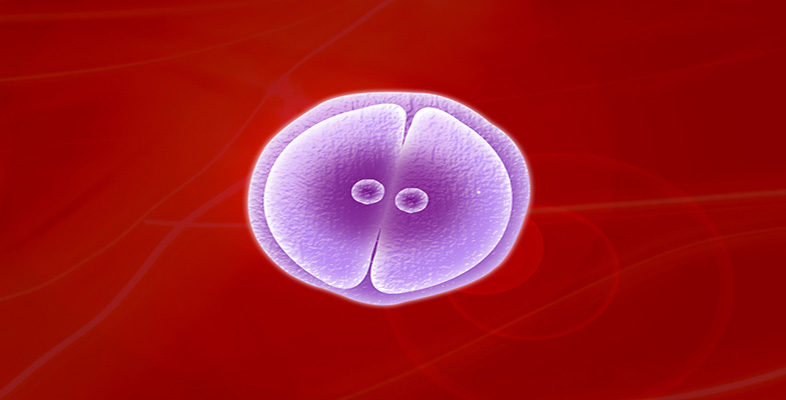3.4 Predicting the outcome of crosses
By knowing the pattern of inheritance of genes as described above, it is possible to make some predictions about the phenotypes and genotypes of each generation in breeding experiments. This section considers some examples of such predictions.
First consider whether it is possible to determine the genotype for certain characters, such as grain colour, from observing an organism's phenotype.
Question 13
Is it possible to determine the genotype of all white-grained cobs just by observing their phenotype?
Answer
Yes, it is possible; since white grain colour is recessive, white-grained cobs must be gg.
Question 14
Is it possible to determine the genotype of all purple-grained cobs just by observing their colour?
Answer
No, it is not possible, because purple-grained cobs may be either G G or Gg. It is possible to say that one copy of the gene must be G but it is not possible to predict the identity of the second copy without further information.
Think back to our original pure-breeding parents (Figure 7). The white-grained parent was gg and any crosses between individuals of that variety would involve only g gametes. All offspring, therefore, must also be gg. Hence this is a pure-breeding variety because all breeding within the variety would lead to offspring that have the same character. Similarly, all the white-grained plants in the F2 generation (Figures 8 and 9) would also be pure-breeding for grain colour when crossed with each other.
Now consider the parental pure-breeding purple-grained variety (Figure 7).
Question 15
Why must this variety be G G and not Gg?
Answer
To be pure-breeding all the offspring must have the same phenotype as the parents — this is the definition of pure-breeding. If the parent variety had the genotype Gg, then a cross between individuals of this variety would produce offspring some of which would be purple-grained and some of which would be white-grained (similar to the cross shown in Figures 8 and 9). Hence it would not be pure-breeding.
Therefore, all members of a pure-breeding variety not only have the same phenotype, but they also have the same genotype.
One of the important things that can be learned from the study of genetics, particularly in the case of humans and agricultural breeding, is that many of the outcomes of inheritance are statistical ones; that is, they are to do with probability, as explained in Box 1, Chance and probability in genetics.
Box 1 Chance and probability in genetics
When tossing a coin there is an even chance that heads or tails will turn up, i.e. each is equally likely. The probability of throwing heads is described mathematically as 1 out of 2, or ½. In general, the probability of a particular outcome, such as heads, is defined mathematically as:

In the case of throwing a six-sided die and getting a 4, there is only one way of getting that outcome, but there are six possible outcomes, so the probability is 1/6.
What would be the probability of throwing an even number with the die?
3/6 or ½, since three of the six possible different outcomes are even numbers.
What is the probability that a gamete produced by a Gg plant will have the white-grained allele?
The probability is ½, since there are two possible outcomes and each one is equally likely. Only one of these corresponds to the white-grained allele.
Recall the reason why each of these two possibilities is equally likely.
It is because the two copies of a chromosome separate from each other into different gametes at meiosis, and in equal numbers.
What is the probability that an offspring of a cross between two maize plants that are heterozygous for grain colour (Gg) will have the white-grained genotype? (Hint: You might find it helpful to draw out such a cross, or to look at the one drawn in Figures 8 and 9.)
The probability is ¼, since there are four possible outcomes (G G, two G g, and g g), and only one of these corresponds to the white-grained genotype.
Again recall that this probability is based on two events: first on an equal number of G and g gametes being produced by each Gg plant; and second, on male and female gametes combining at random at fertilisation.
Question 16
What is the probability that an F2 maize grain, shown in Figures 8 and 9, will contain at least one g allele?
Answer
There are four possible outcomes: G G; two g G; and g g. Since three of the four possible fertilizations contain at least one g allele, the probability that the offspring will contain at least one g allele is 3/4
So far in Section 3 we have considered only two types of cross, one between two pure-breeding varieties which gives rise to the F1 generation, and one between F1 individuals which gives rise to the F2 generation. However, other crosses can be carried out and they show that inheritance of the copies of a gene follows the same basic rules. An understanding of probability, the relationship between dominant and recessive alleles, and the way that the two copies of a gene segregate at meiosis, enables us to predict the outcome of many breeding experiments.
Let's consider an example. Suppose a breeding experiment was carried out in which plants from a pure-breeding white-grained variety of maize (gg) were crossed with heterozygous maize plants of genotype Gg. What are the expected genotypes and phenotypes in the offspring arising from this cross, and in what ratio would they occur? We can begin to answer this question by first determining the genotypes of the gametes produced by each of the parents. The pure-breeding white-grained plants (gg) will produce gametes that all carry the g allele, as shown in Figure 11. The heterozygous Gg plants will produce gametes, half of which carry the G allele and half the g allele (Figure 11).
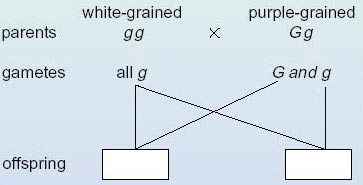
Activity 6
What symbols should be entered into the empty boxes in Figure 11 and hence determine the ratios of the genotypes and phenotypes of the offspring?
Answer
The completed Figure 11 is shown in Figure 11a. The ratio of the genotypes of the offspring will be 1 G g : 1 g g, and the phenotypic ratio will be 1 purple : 1 white.
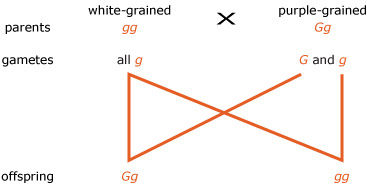
The expected outcome of the cross reveals a further important genetic ratio of 1:1. This ratio confirms that during meiosis alleles G and g in a Gg plant segregate from each other into equal numbers of gametes containing G and g alleles, and that fertilisations between these gametes and those of the other parent occurs at random and therefore both possible combinations are equally likely.
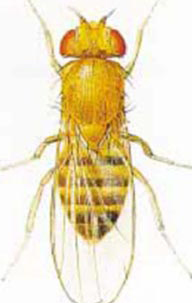
We have seen that the phenotypes of members of each generation in a breeding experiment can be understood by using a model of inheritance. This model involves representing alleles by letters. The relative proportions of the possible combinations of letters then account for the ratio of the phenotypes. In fact this is an example of mathematical modelling; the mechanism of inheritance is regarded as equivalent to a mathematical process whose consequence can be calculated by the well-established laws of chance and probability.
In the next two questions you are asked to predict the results of some different sorts of crosses using the same rules of dominant/recessive alleles, the segregation of the two copies of a gene and the combining of gametes at random.
Activity 7
A breeding experiment was carried out in which plants from a pure-breeding purple-grained variety of maize were crossed with plants that were heterozygous for grain colour. Draw the mating diagram for this cross and then predict the genotypic and phenotypic ratios of the offspring.
Answer
The mating diagram for this cross is shown below.
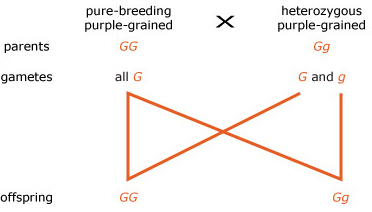
The genotypic ratio of the offspring is 1 G G : 1 G g ; the phenotype of all the offspring is purple-grained, since they all carry at least one, dominant, G allele.
Activity 8
Which, if any, of the following breeding experiments in the common fruit-fly (Drosophila melanogaster), shown in Figure 12, could have involved parents that were pure-breeding for eye colour? Assume that red eye colour is dominant to brown eye colour. Give reasons for your choice, and reasons for rejecting any options you do not choose.
-
300 brown-eyed flies are crossed with 300 red-eyed flies. All the offspring are red-eyed.
-
300 brown-eyed flies are crossed with 300 red-eyed flies. Half of the offspring are brown-eyed and half are red-eyed.
-
300 brown-eyed flies are crossed with 300 brown-eyed flies. All of the offspring are brown-eyed.
Answer
Brown-eyed parents must be pure-breeding in all cases, since their genotype must be homozygous recessive.
(a) The red-eyed parents must have been pure-breeding; had they not been pure-breeding, then two different phenotypes would have been observed in the offspring. The situation is analogous to the maize example shown in Figure 7.
(b) This experiment cannot have involved pure-breeding red-eyed parents. If the red-eyed parents had been pure-breeding, all of the offspring would have been red-eyed.
(c) The crosses between the brown-eyed flies produce brown-eyed offspring, and this is the result you would expect to find if the parental lines are homozygous recessive.
Activity 9: Tackling problems in genetics
This activity provides hints on how to tackle problems in genetics that you will be expected to solve.
General hints for tackling problems in genetics
Here we will offer some guidelines on how to set about solving genetics problems, and you will then tackle a problem using these guidelines. You need to bear in mind that genetics problems cannot be solved by rote learning; each one has to be tackled afresh using your understanding of genetic principles, common sense, and sometimes trial and error. Here is a list of guidelines, which should help you to tackle a wide range of genetics problems; you may need to adjust the order in which you work through the steps according to the information given in the question.
Read the question and make sure that you understand all of the terms that are used (e.g. pure-breeding, heterozygous, etc.).
Draw out the crosses as mating diagrams, using one of the two alternative layouts shown in Figures 8 and 9, and include all the information that is given in the question, e.g. pure-breeding tells you that a variety is homozygous. This will help you to think about the problem logically, and show what information you need to deduce, e.g. the genotypes of one or more of the generations involved.
Assign letters to the alleles of the genes, or the copies of genes, that are involved, if they are not specified in the question. You may need to use information provided in the question to deduce which phenotype is dominant and which is recessive; for example, if a particular phenotype disappears in the progeny of one generation and reappears in the next generation, you can infer that this phenotype is recessive to the phenotype that is masking its presence.
Complete the mating diagram; for example, use the genotypes of each generation to deduce the genotypes of the gametes, and use the genotypes of the gametes to determine the genotypes of the offspring. (With some problems you may be working from genotypes of offspring back to the genotypes of the parents.)
Use information about the dominant allele or character to determine the phenotypes of each generation. (In some problems, such as the one given here, you will start by using phenotypes to determine genotypes.)
Calculate the ratios of the genotypes and of the phenotypes from the mating diagram.
Ask yourself whether the results are consistent with what you have learned about genetics and probability.
We suggest that you tackle the following problem using the above guidelines.
A genetics problem
The fruit-fly Drosophila melanogaster is widely used by geneticists for breeding experiments in the laboratory because it is easy and cheap to rear and each female produces hundreds of eggs. Suppose that you carry out a breeding experiment using two pure-breeding varieties of D. malanogaster, one with normal-shaped eyes and one with eyes reduced to about half the normal size, called 'eye-less'. The first cross is between these two varieties. The F1 offspring all have normal eyes. The second cross is between an F1 normal-eyed fruit-fly and a pure-breeding eye-less variety. What is the expected ratio of genotypes, and the expected ratio of phenotypes of the offspring of the second cross?
Answer
We solved the problem by working through each step in the guidelines in turn:
1. Pure-breeding parents, by definition, must be homozygous, since they breed true; since the two varieties have contrasting characters, they are homozygous for different alleles of the gene for eye shape.
2. We drew out a mating diagram using the information given in the question:
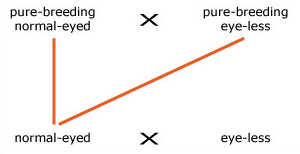
3. Next we assigned letters to alleles of the gene for eye shape. Since normal shape appears in the F1 generation we deduced that normal shape is dominant to eye-less; we used EE for normal-eyed flies and ee for eye-less, but you may have chosen a different letter.
4 We then drew the mating diagram as shown in Figure b. (The normal-eyed F1 fly must be heterozygous (Ee) since it is the offspring of EE and ee pure-breeding parents. All eye-less flies must be ee because this phenotype is recessive.)
5. The phenotypes of the offspring of the second cross are (Ee) normal-eyed (since E is dominant to e) and (ee) eye-less.
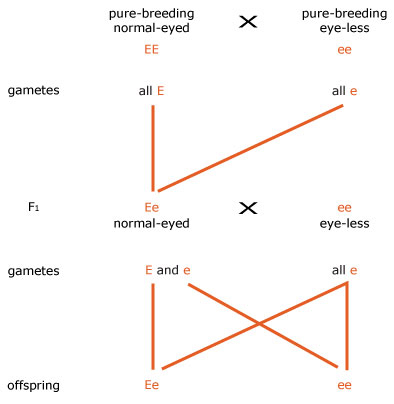
6. The ratio of the two genotypes of the offspring of the second cross is 1 Ee : 1 ee, and the ratio of the two phenotypes is one normal-eyed (Ee) : one eye-less (ee).
7. The results appear consistent with what we know of genetics, and the ratio is a familiar genetic ratio.
You can use the guidelines again when tackling genetics problems later in the course.
